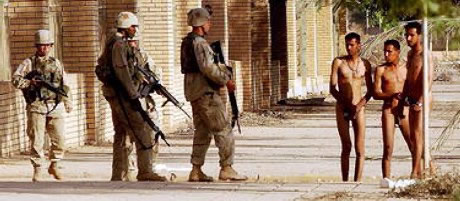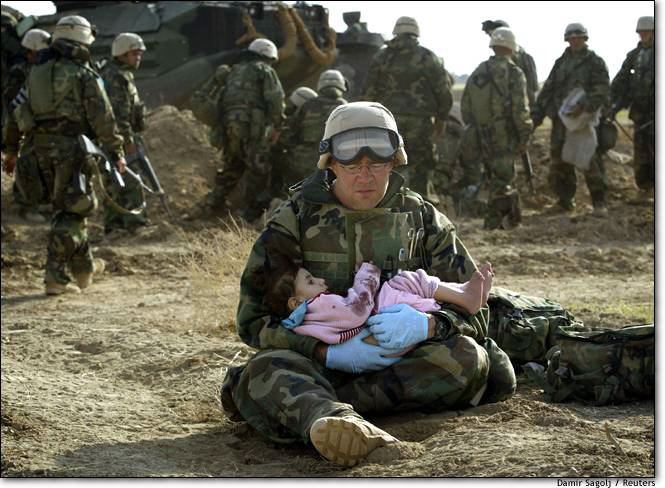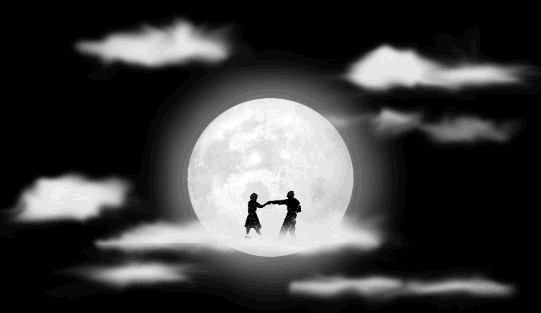|
Here and there |
||||
|
|
||||
|
Sadam 'Surgery' Iraq's new government, which takes power at the end of the month, is now preparing its plans for the future. But as it does so, the country is still dealing with the legacy of a brutal past. One of the most shocking of many abuses committed by Saddam Hussein's regime was a campaign in 1994 to punish army deserters by amputating their ears.
But there is now new hope for the victims. In a busy hospital clinic, Noful Daoud has his blood pressure checked. It is a very different treatment from the last time he saw a doctor, a decade ago, when a surgeon sliced off both his ears as his punishment for deserting from Saddam Hussein's army. It happened, he says, the day Saddam's order was given out. "I was taken to Basra Hospital and blindfolded," he said. "They cut off my left ear by mistake and so they chopped off the right one as well. Without my ears, I haven't been able to get a job or get married." Return to normal This Baghdad hospital specialises in reconstructive surgery. Its corridors are crammed with the victims of bombs and bullets. But look carefully through the crowds and you'll see one very distinct kind of patient - men like Noful, who are here to get their ears rebuilt. There are no exact statistics of how many army deserters were mutilated by having one or both ears amputated, but doctors estimate that there are around 3,500 of them, and Iraq's ministry of health has just begun offering them free surgery. "It is very complicated, very intricate, and there are complications, of course," says Ahmad Jawad, the doctor behind the programme. Shunned "The results may not be 100% but we try to get them physically normal so that if they wish and have determination they could go back to their community, find jobs, get married and get on with their lives." Noful, lying on a stretcher, ready for his operation, discusses his feelings about Saddam Hussein with doctors and nurses. He was 19 when Saddam's decree was implemented. Since then, he has worn a traditional Arab head-dress to hide what he still sees as the shame of his mutilation. Men like Noful were shunned by many Iraqis, who under Saddam were too afraid to associate with them. So, as the nurses make the final preparations for his surgery, Noful is smiling. Undoing damage Under general anaesthetic, they slice into the skin behind where his ears should be. Some patients will have cartilege taken from their ribs for the reconstruction, but Noful is having artificial silicon ears. In two months' time he'll need to come back for more surgery to graft new skin onto them. Noful's surgeon, Ridha Ali, is delighted to be able to undo the damage done by fellow doctors, who were forced to amputate ears on pain, he says, of having the same done to them if they refused. "It is a great thing that I can do now for my people, especially when they are victims of the previous regime of Saddam," he says. "It's a great chance for me and for others to help these people, of course. We feel very happy to do this job." Noful still has to recover from the physical trauma of his surgery, but the deep emotional pain of being a pariah is being taken away here in the operating theatre, and Noful hopes it will pave the way for him to find first a job, and then a wife. Bad and Good, war is nasty anyways

Siamak |
Greenland
Melt May Swamp LA, Other Cities, Study Says Thursday 08 April 2004 Greenland's massive ice sheet could begin to melt this century and may disappear completely within the next thousand years if global warming continues at its present rate. According to a new climate change study, the melting of Greenland's ice sheet would raise the oceans by seven meters (23 feet), threatening to submerge cities located at sea level, from London to Los Angeles. Even a partial melting of the ice sheet could have catastrophic consequences for low-lying countries like Bangladesh and the Maldives. "A one-meter [three-foot] sea level rise would submerge a substantial amount of Bangladesh," Jonathan Gregory, the study's lead author and a climate scientist at the University of Reading in England, said in a telephone interview. Scientists have previously calculated that if the annual average temperature in Greenland increases by almost 3° Celsius (5.4° Fahrenheit), its ice sheet will begin to melt. Many experts believe the concentration of carbon dioxide in the atmosphere will have reached levels around the year 2100 that would cause the temperature to rise that much. "We're not saying how long it will take to get to the three degrees or how long it will take to lose the ice sheet," Gregory said. "We're saying there's a high likelihood of passing this threshold of viability with the carbon dioxide levels that are currently being considered." The research is described in this week's issue of the science journal Nature. Global Warming The issue of global warming is controversial. It's clear that, since the Industrial Revolution, atmospheric concentrations of carbon dioxide have increased 30 percent, enhancing the heat-trapping capability of the atmosphere. Scientists generally believe that the combustion of fossil fuels to run cars, heat homes, and power factories is the primary source for this increase in carbon dioxide levels. In the absence of emissions control policies, the United States Environmental Protection Agency says carbon dioxide concentrations will be 30 to 150 percent higher than the current 370 parts per million (ppm) found today. Meanwhile, the global surface temperature increased 0.6° Celsius (1.8° Fahrenheit) in the last century. Oceans have become warmer, too, expanding while storing heat. This has caused sea levels to rise 4 to 8 inches (10 to 20 centimeters) in the last hundred years. While most scientists agree that higher greenhouse gas concentrations, particularly carbon dioxide, are causing global warming, a few scientists argue that atmospheric carbon dioxide levels may not be the only culprit, because they have remained relatively steady for the past 30 years. Different Scenarios At the present temperatures, about half of the snow that falls on Greenland melts and runs off as water. The rest of it stays and is discharged in the form of icebergs. An increase of 3° Celsius (5.4° Fahrenheit) would change that equation, producing an increase in melting that will outweigh the increase in snowfall, according to Gregory. "The warmer it gets, the more melting there is," he said. "You would also expect more precipitation, but most studies suggest that the increase in melting would be bigger. Beyond that threshold [of a 3° Celsius temperature increase], the ice sheet will likely not be viable and would just get smaller and smaller." The study considered the climate sensitivity of a range of climate models and a range of carbon dioxide scenarios, from 450 parts per million, the lowest level considered by the United Nation's Intergovernmental Panel on Climate Change, to a thousand parts per million, or four times the pre-industrial carbon dioxide concentration. "They demonstrate that a warming of about 3° Celsius for ongoing melting of the Greenland ice sheet is exceeded by 2100 for the majority of cases considered," said John Church, a climate scientist at the Australian government CSIRO Marine Research center in Hobart who was not involved in the study. In the most extreme scenario, using a carbon dioxide level of 1,000 ppm, the study predicts temperatures to rise by 8° Celsius (18° Fahrenheit) by the year 2050. This, in turn, would raise sea levels by 7 meters (23 feet) in a thousand years. "This is a high concentration, but it is within the range of scenarios that people have considered," Gregory said. "It's not a completely outrageous number." Sinking Cities If rising temperatures were to cause melting of Greenland's ice sheet, the process would be gradual. There's no evidence that the ice sheet would catastrophically disintegrate. Even the worst scenario is unlikely to alter the world map. "If you were to raise the sea levels by seven meters [23 feet] and look at a map of the world, you probably wouldn't think it was startlingly [different]," Gregory said. "But of course many of the places where a lot of people live are close to sea level." Many cities and communities along the U.S. Eastern Seaboard are at least partly below this level. "Sea level rise has the potential to affect millions of people living in low-lying coastal regions, particularly the inhabitants of megacities developing on coasts around the world and those living on deltas of major rivers and small island nations," Church said. Gregory and other scientists warn that even if the composition of the atmosphere could be reversed to pre-industrial conditions, the sea level rise could be irreversible. Once it's gone, the Greenland ice sheet is unlikely to be reestablished.
|
"Sea level represents one of the longer time scale responses found in the climate system," said Ronald J. Stouffer at the U.S. National Oceanic and Atmospheric Administration's Geophysical Fluid Dynamics Laboratory in Princeton, New Jersey. "It may not be possible to stop or
reverse this process once it has been underway for a period of time,
even though the climate returns to a relatively cool state,"
Stouffer said. Venus appears as black spot against the sun in rare astronomical event visible in Hong Kong.
In 1992, Khalili offered to lend the British government his collection, which includes rare illustrated Korans, medieval arms, jewellery and ceramics. Under the proposed deal, the government was to have provided a museum building. He also later offered his work to the British Museum on a 15-year loan, but then withdrew his offer when negotiations dragged on.
The fire at an east London art warehouse last week has pointed up the amount of valuable and significant art work which is held in storage in Britain. Many collectors increasingly feel they have a moral duty to find new ways to display their possessions, especially as work held together in bulk may be at greater risk.
|
||






